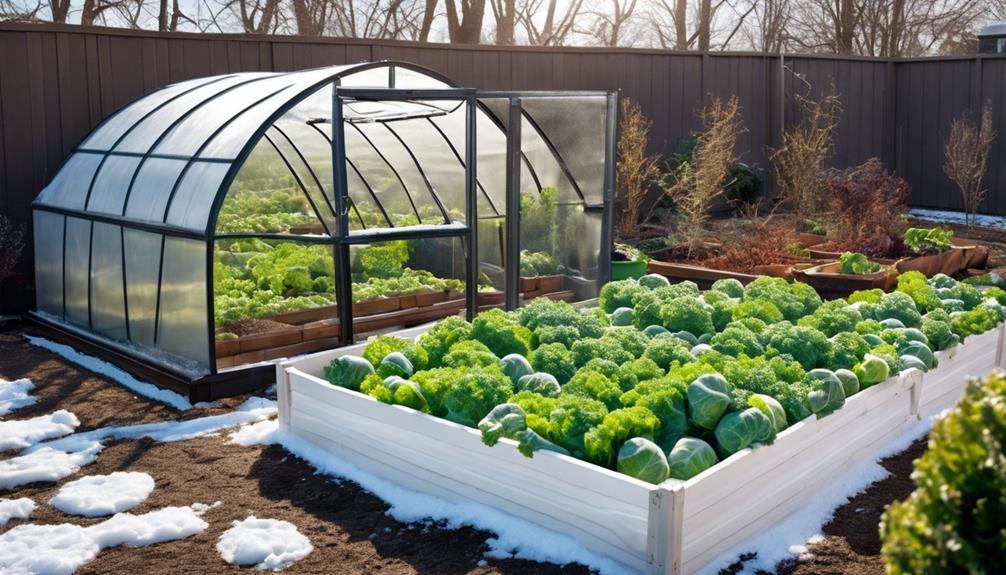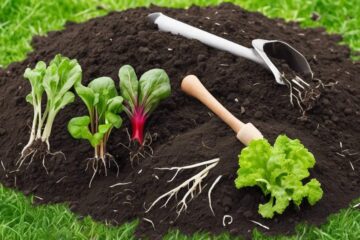If you've ever wondered how to keep your garden thriving during chilly weather, exploring the world of cold climate veggies could be the answer.
Discover the secrets behind successfully growing these resilient plants in your own backyard, from selecting the right varieties to implementing smart cultivation techniques.
Uncover the key to enjoying a bountiful harvest even when the temperatures drop – your winter garden might just surprise you with its abundance.
Benefits of Cold-Weather Vegetables
Growing cold-weather vegetables can significantly enhance your gardening experience and yield a plethora of benefits. Hardy vegetables, such as kale, carrots, and Brussels sprouts, thrive in cool weather conditions. These frost-hardy varieties not only extend your growing season but also provide fresh produce during the winter months.
Selecting the Right Vegetable Varieties
To ensure successful growth in a cold climate, selecting the right vegetable varieties with cold tolerance and frost resistance is essential. When choosing which vegetables to grow in cool temperatures, opt for hardy cultivars that can withstand frost and lower temperatures. Consider the average winter temperatures in your region to guide your selection. Look for specific varieties recommended for cold climate gardening to increase your chances of a successful harvest. Seeking advice from local gardening experts or extension services can also provide valuable insights into the best vegetable options for your area.
| Vegetable Variety | Cold Tolerance | Frost Resistance |
|---|---|---|
| Carrots | High | Moderate |
| Kale | High | High |
| Brussels Sprouts | High | High |
Understanding Planting Dates and Seasons
Understanding the planting dates and seasons is crucial for successful cold climate vegetable gardening. Planting dates for cold climate veggies are determined by the temperatures and frost patterns in your area. Early spring planting allows for a longer growing season in colder climates, while fall planting of cold-hardy vegetables ensures a bountiful harvest before winter arrives.
It's essential to know your local climate and frost dates to plan your planting schedule effectively. Different vegetables have specific planting windows to thrive in cold climates, so paying attention to these details can make a significant difference in the success of your cold climate garden. By being aware of the planting dates and seasons, you can maximize your harvest and enjoy fresh produce even in chilly weather.
Soil Preparation Tips for Cold Climate Veggies
To prepare the soil effectively for your cold climate veggies, ensure it's well-drained and maintains a pH level between 6.0-7.0.
Adding compost or organic matter can enhance the soil structure and nutrient content, promoting growth for cold-tolerant vegetables. Make sure the soil is loose and friable to facilitate root penetration and nutrient uptake.
Consider conducting a soil test to assess nutrient levels and adjust as needed for optimal plant development.
Raised beds are advantageous for cold climate veggies, offering improved drainage and warmer soil temperatures, which can enable earlier planting.
Utilizing raised beds can create a favorable environment for your cold-tolerant vegetable garden, enhancing its overall success.
Watering and Fertilizing Guidelines
Ensure deep root growth and drought resistance in your cold climate vegetables by watering them deeply and infrequently. To properly care for your cold weather crops, follow these watering and fertilizing guidelines:
- Deep Watering: Water deeply but less frequently to encourage roots to grow deeper into the soil.
- Moisture Monitoring: Use a moisture meter to prevent overwatering, which can cause root rot in cold, wet conditions.
- Balanced Fertilizer: Apply a balanced fertilizer with higher potassium levels to help your vegetables resist frost and enhance overall health.
- Organic Options: Consider organic fertilizers like compost or fish emulsion to provide nutrients without the risk of chemical burn.
Adjust your watering and fertilizing routines according to the specific needs of each cold climate vegetable for optimal growth.
Pest and Disease Management Strategies
To protect your cold climate vegetables from pests and diseases, implementing effective management strategies is crucial. Implement crop rotation to prevent the build-up of pests and diseases in the soil.
Practice intercropping with companion plants that naturally repel pests or attract beneficial insects. Use organic pest control methods like neem oil, insecticidal soap, or diatomaceous earth to manage pests.
Monitor plants regularly for signs of infestation or disease and take prompt action to prevent spreading. Properly dispose of infected plant material to prevent the spread of diseases in the garden.
These strategies will help you safeguard your cool climate veggies from potential threats, especially during light frosts, ensuring your plants stay healthy and productive.
Harvesting and Storing Cold-Hardy Vegetables
Harvesting and storing cold-hardy vegetables is essential for maintaining their freshness and quality. To ensure you do this effectively, consider the following tips:
- Harvest in the Morning: Pick your cold-hardy vegetables early in the day for the best flavor and nutritional value.
- Use Sharp Scissors: Cut the leaves with sharp scissors to make harvesting easier.
- Start with Outer Leaves: Begin by harvesting the outer leaves to promote new growth on the plant.
- Storage in Cool Places: Store your harvested vegetables in a cool location to preserve their quality, especially during lower temperatures and varying weather conditions.
Frequently Asked Questions
What Vegetables Grow Best in Cold Weather?
For the best veggies in cold weather, choose from kale, spinach, Brussels sprouts, carrots, beets, parsnips, broccoli, cauliflower, cabbage, onions, garlic, leeks, and leafy greens like kale, Swiss chard, and arugula. Enjoy your winter harvest!
What Is the Lowest Temperature Vegetable Plants Can Tolerate?
You'd be surprised by how tough certain veggies are. They can handle lows down to 15°F. These resilient plants include kale, Brussels sprouts, leeks, broccoli, cabbage, beets, carrots, radishes, collards, and mustard. They thrive in cooler conditions.
What Are Some Cold Vegetables?
You can grow a variety of cold vegetables like kale, spinach, Brussels sprouts, and carrots. These frost-resistant plants are perfect for fall and winter gardening. Extend your growing season and enjoy fresh produce in colder months.
What Root Vegetables Grow in Cold Climates?
You can grow root vegetables like beets, carrots, parsnips, and radishes in cold climates. They thrive in chilly conditions and offer a reliable source of fresh produce. These frost-tolerant veggies are perfect for winter planting.
Conclusion
Now that you've learned how to grow cold climate veggies, it's time to put your knowledge to the test.
Get your hands dirty, sow those seeds, and watch your resilient vegetables thrive in the chilly weather.
Embrace the challenge, enjoy the process, and savor the taste of your homegrown produce.
Who knows what other hidden talents and strengths you might discover along the way.
Happy gardening!





